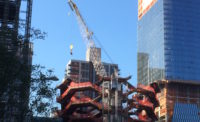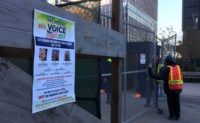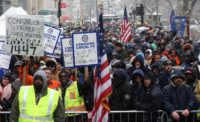The developer of a New York City high rise and the project's former prime contractor are trading unusually nasty safety related accusations in a dispute over the contractor's exit from the project. The contractor, New York City-based Pizzarotti, claims the settlement of the structure in soft soils creates hazards in future work that could send building components crashing to the streets. In reply, developer Fortis Property Group says the contractor’s uneven pace of work is to blame for what it sees as only slab misalignments that don’t compromise safety in any way.
The lawsuit pleadings, filed during the last month in state court in Manhattan, apparently come after a long downhill slide in the working relationship between the two companies.
Contract disputes rarely involve accusations that one party or another is endangering project workers or the public, attorneys say. When they do it usually concerns safety violations that resulted in penalties or environmental hazards.
The lawsuit pleadings, filed during the last month in state court in Manhattan, involve a project known by its address: 161 Maiden Lane. The legal filings apparently come after a long downhill slide in the working relationship between the two companies. Fortis had hired Pizzarotti in December 2015 to build the slender, cast-in-place concrete-framed apartment building near Manhattan's downtown financial district. The contract value was about $80 million. Another New York City company that was representing Fortis on the project, Ray Builders Inc., now is serving as the general contractor.
What precipitated Pizzarotti's exit is unclear. In a lawsuit seeking an injunction against Fortis, Pizzarotti claims that the design of the building's foundation has caused differential settlement. During construction the settlement allegedly imperils workers and bypassers with potential breaking windows and falling building components. Leaks and waterproofing could also become unmanageable, too, Pizzarotti claims.
In an engineering report submitted to the court with Pizzarotti's pleading, the contractor claims that in 2014 Fortis and its foundation consultant decided to use a soil improvement technique rather than drill deep piles. The project’s structural engineer, the report states, anticipated 2 in. of differential settlement and provided horizontal offsets of the column and shear wall locations of the 45th to 49th floors so that the lean would be mitigated in the upper levels. But the use of soil improvement meant that settlement of another 1 inch would continue during construction, the contractor claims, and it was never informed about it. That settlement, Pizzarotti says, has fouled up the curtainwall subcontractor's work and poses dangers in construction.
Pizzarotti claims it fell behind as critical path work stalled for 120 days and also contends that the delay under its construction management agreement entitled the company to terminate its contract. The lawsuit seeks injunctive relief from an anticipated claim by Fortis.
Not true, argues Fortis in court pleadings filed on April 30th. The developer says the entire scenario laid out by Pizzarotti is a cover for the fact that the contractor had fallen months behind on its work, including numerous shutdowns imposed by the New York City Dept. of Buildings for alleged safety violations. City officials could not immediately be contacted for confirmation.
Fortis calls Pizzarotti’s lawsuit “nothing more than bad faith gamesmanship” to gain leverage over Fortis in anticipation of the developer making a “massive claim” against the contractor. The building is safe, Fortis declares. While there have been some slab edge misalignments, the city’s Dept. of Buildings “is aware of and has accepted the very condition which Pizzarotti wrongfuly asserts is unsafe.”
Fortis said it had notified Pizzarotti and its sureties, Fidelity and Deposit of Maryland and Zurich North America, that it was considering terminating Pizzarotti and did just that effective April 2nd. The bond has a penal sum of $78.5 million, says Fortis, and the surety can evaluate its options for completing the project.
But in essence, Pizzarotti’s lawsuit is a matter of “crying wolf,” the developer states. The contractor, Fortis claims, and its subs continued to perform work on the project throughout the alleged 120-day stoppage period during which Pizzarotti’s says it was waiting for instructions from Fortis’ engineers.
Moreover, Pizzarotti had all the information it needed about the soil plan and foundation design in the early stages of its work and was “explicitly made aware of” the potential settlement, Fortis states. In fact, claims Fortis, stop-work orders related to safety violations imposed by New York City’s Dept. of Buildings resulted in the “uneven additions to the load as borne by the foundations—an important causative element of misalignment.”






Post a comment to this article
Report Abusive Comment